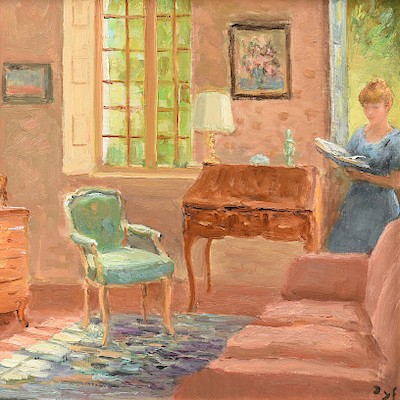GEORGE CHAMBERS JR. (English 1829-1878) A PAINTING, "Mariobos Volcano," CIRCA 1862,
About Seller
6116 Skyline Drive, Suite 1
Houston, TX 77057
United States
Simpson Galleries has been serving Houston’s need for the very best in antique sales venues for more than fifty years. Beginning in 1962, William Simpson started educating himself and others in the art of collecting fine antiques and art objects. Simpson Galleries' commitment to excellence and accur...Read more
Two ways to bid:
- Leave a max absentee bid and the platform will bid on your behalf up to your maximum bid during the live auction.
- Bid live during the auction and your bids will be submitted real-time to the auctioneer.
Bid Increments
| Price | Bid Increment |
|---|---|
| $0 | $25 |
| $500 | $50 |
| $1,000 | $100 |
| $2,000 | $250 |
| $5,000 | $500 |
| $10,000 | $1,000 |
| $20,000 | $2,500 |
| $50,000 | $5,000 |
| $100,000 | $10,000 |
| $200,000 | $25,000 |
About Auction
Sep 21, 2019
European avant-garde and German Expressionist printmaking from the family of collector Ismar Littmann including examples from Manet, Renoir, Kollwitz, and a compilation following the career of artist Max Pechstein. Texas and regional art is well represented, as well as, historically significant maps Simpson Galleries online_auctions@simpsongalleries.com
- Lot Description
GEORGE CHAMBERS JR. (English 1829-1878) A PAINTING, "Mariobos Volcano," CIRCA 1862, oil on canvas, signed L/L, "G. Chambers." 31 1/4" x 59 1/4" Note: "George Chambers, Jr., was the son of the well-known English marine painter of the same name, George Chambers. By the age of eighteen, George Chambers Junior was finding willing patrons and was exhibiting at the British Institution. Two years later, in 1850, the Royal Academy exhibited "Hatch boat crossing the mouth of the River Thames," and thereafter the artist was to display at least one or two of his paintings every year until 1861. In 1862, Chambers mysteriously vanished from the London art scene and it is likely that it was at this time that he traveled to Central and South America. The jungles of this continent have fascinated the outside world from the time of their discovery to the present day, and during the nineteenth century interest in this continent reached its zenith. Following Columbus's 1492 discovery of the New World, the Spanish government restricted travel to this territory and with only the early accounts of the conquistadors and missionaries as sources of information, the allure of Central and South America grew. It was a continent filled with mystery with recurring legends of El Dorado, the Enchanted City of Patagonia and the island of the Amazons. Chambers painting displays two of the volcanoes in the Maribios volcanic range running parallel to Nicaragua's Pacific coastline. Another undated work by him entitled The Lake of Managua, Nicaragua, Central America, showing the Volcano Momotombo, is evidence of the artist's visit to this region, although it is not known when the journey was made. Like many artists who visited South and Central America, George Chambers Jr. was fascinated by the triangular, or conical, formation of the volcano. Not only did it correspond to classical precepts of the ideal composition but its platonic geometry was seen to connote divine creation. Indeed, nineteenth-century religious precepts regarded the shape and mighty power of the volcano as direct evidence of God's hand in creating a landscape untouched since creation. In this scene, we are presented with not only two volcanoes in the background, but the fertile lands that surrounds them and which, in Chamber's time, were beginning to be dotted with cotton and sugar plantations. While indigenous workers labor in cutting down the vegetation to the left of the scene, an expeditionary party, perhaps that of Chambers, travels across the lowland plain. A magnificent Quetzal bird is shown flying over the village in the center of the picture. The Quetzal was revered by the Mayans for centuries, and can be found in much of their art. The Mayans thought of the Quetzal as a magical, mythical bird of great healing power." Courtesy: Arader Galleries. Provenance: Property from a South Texas Collector.Canvas now cut down and laid to canvas, but overall in good to very good condition, wear commensurate with age. Simpson Galleries strongly encourages in-person inspection of items by the bidder. Statements by Simpson Galleries regarding the condition of objects are for guidance only and should not be relied upon as statements of fact and do not constitute a representation, warranty, or assumption of liability by Simpson Galleries. All lots offered are sold "AS IS."
Condition
- Shipping Info
-
**SIMPSON GALLERIES, LLC. DOES NOT PROVIDE SHIPPING SERVICES OR SHIPPING QUOTES.** Shipping may be secured through - The UPS Store: store2567@theupsstore.com 281-764-9551, The UPS Store: store3229@theupsstore.com 713-334-8869, PACK-N-SEND: sales@pack-n-send.com 713-266-1450, ACTS Crating and Transportation Services: crating@actsintl.com 713-869-2269, NAVIS Pack & Ship: 17013tx@gonavis.com 713-352-3038, Wintersteen Trucking: wintersteentrucking@yahoo.com 800-253-0617, or the shipper of your choice.
-
- Buyer's Premium



 EUR
EUR CAD
CAD AUD
AUD GBP
GBP MXN
MXN HKD
HKD CNY
CNY MYR
MYR SEK
SEK SGD
SGD CHF
CHF THB
THB



























